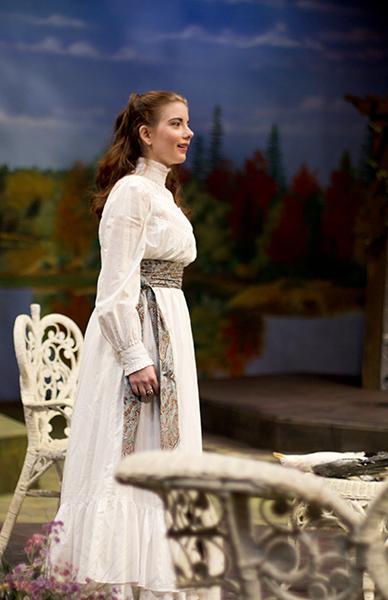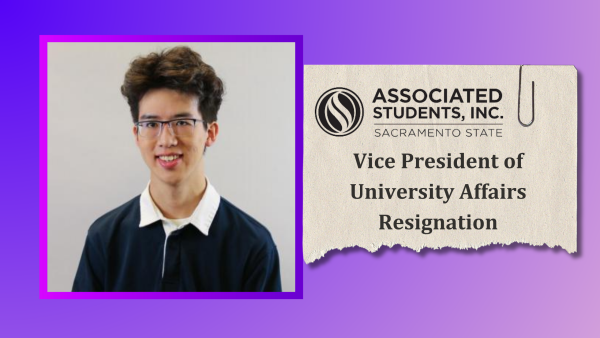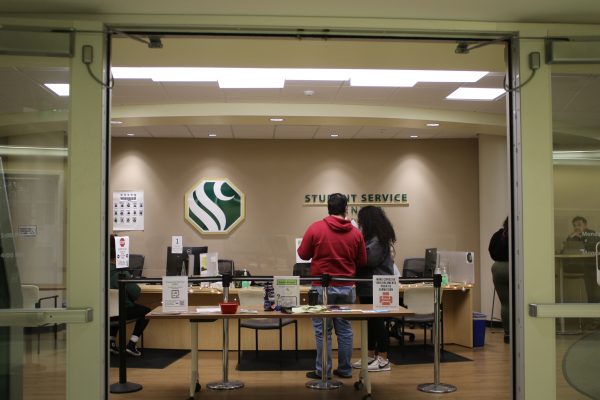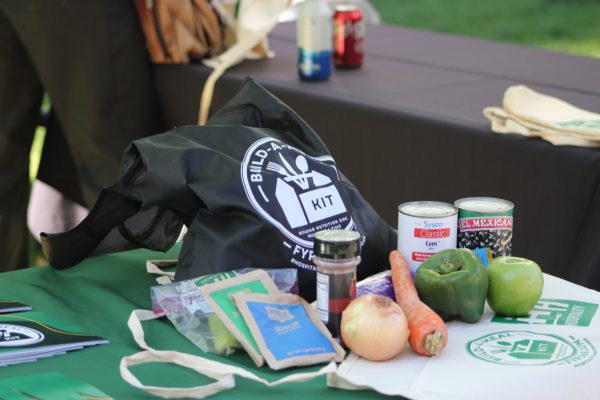‘The Seagull’ to offer love, drama, intrigue

Nina, played by senior theater major Rachel Williams, watches as a fellow cast member walks off set during the play “The Seagull” on Monday.
November 9, 2011
People tend to love drama, suggested by society’s general fascination with shows like “Jersey Shore” and “The Real World.” Anton Chekov’s play, “The Seagull” is riddled with romantic and artistic differences between the characters – and it is now at Sacramento State.
Michelle Felton, assistant professor of acting in the dance and theatre department, is the director of “The Seagull,” which opens tonight at 8 p.m. in the Playwrights’ Theatre located in Shasta Hall at Sac State. This is Felton’s fifth time directing a play at Sac State and first time directing a Chekov play. Felton said she first began her career in theatre as an actress and six years ago she made the transition from actress to director.
“All my training is in acting, so I am actually an actress … and have toured the country,” Felton said. “If you are an actress and are going into the academic world, then it naturally progresses into directing. For me, it was a natural progression based on where my career went.”
Felton is familiar with the style of Chekov’s “The Seagull”, the style that is classic-realism, but she had not previously worked with this specific play.
“Chekov literally brought regular, everyday life to the stage versus blowing it up so it was so unbelievable and not relatable,” Felton said. “There is modern-realism, which is 90 percent of what movies are today and what most plays are. Then we have classic-realism, which is also realistic, bringing a realistic style to the stage. But it takes place in a time period that is not familiar to us or not our own.”
The play invites the audience in to watch the lives of four main characters that are set in the Russian countryside at the end of the 19th century. Viewers see each character trying for love, success or fame in this play that focuses on the human life.
Auditions, which were open to the public, were a three-day process held the third week in September. Junior theatre major Diona Burnett said she went her own route in preparation for the audition.
“The first audition went really well,” Burnett said. “Usually with auditions I get really nervous and I go over my monologue over and over again, which you’re not supposed to do because you’ll question something and then forget it, but I auditioned and that went really well.”
Senior theatre major John Young said he was not thrilled with his audition.
“I didn’t feel too strong about my initial audition,” Young said. “Though all actors are critical of themselves, even if they were great, they will always focus on what they could have done better. But I knew from before auditioning, I wanted the part that I have. I’m not saying I necessarily like or dislike the character as a person, but I just can understand the character.”
Once the cast list went up, rehearsals started. The production period for “The Seagull” took six weeks. Production consisted of not only rehearsals for the actors, but also getting the set, props and costumes together.
Felton said the set has three separate platforms: one for when the actors are “outside,” and the other two are used when the actors are “inside.” The costumes entail Russian style dresses with high necks that are long and full, for the aristocratic women, and Russian style clothing for the men. While Felton was not able to remember the exact number for production cost, she did say that the theatre department is as resourceful as possible.
“We do everything basically in house, especially when it comes to the sets,” Felton said. “So a lot of it is sort of recycled material. Some of the costs would (go to) paint and the backdrop. We brought in a costume designer for all the period costumes. Some costumes have to be rented, some they make and some are pulled from stock.”
Some of the cast members have known they want to act for a living from a young age, and others figured it out later in life, but regardless, the actors seem to enjoy the classic-realism style of Chekov’s play. Junior theatre major Sandra McCord said she has learned to embody her character, though there have been a few kinks.
“(My character) Serena falls asleep and people notice her snoring,” McCord said. “I have never had to snore on stage before and I’m having a difficulty getting a loud snore. At the moment, mine are more like snorts. That has been the hardest thing for me in this play – being able to snore on cue.”
McCord said she got involved with acting later in her life, but she knew from a young age that she wanted to act. She said within the last 15 years she has finally been able to fulfill a dream of hers. Burnett said she found her love for acting in a different way.
“I was really shy in high school and I didn’t want to do theatre at all because I didn’t think I would be good at it,” Burnett said. “Then I came here (to Sac State) and my father told me to declare theatre as my major. I got involved … and that’s how I got started. I love this; it’s what I want to do forever.”
Young said his first play he performed in was in grade school, but said it does not count.
“My junior year of high school I started doing more theatre,” Young said. “My first play would technically be ‘The Shoemaker’ when I was in second grade, but the first real play I was in was ‘Once in a Lifetime.'”
During the rehearsal process, there was a long-running kissing joke about the kissing scenes, Young said. Young said when Stanislovski, who published the technique of method acting, directed “The Seagull,” it was wildly successful. Yet he was so precise, that he made the kiss eight seconds.
“So every time that we practice the kiss, if it’s not eight seconds, (the cast) always make fun of us for it not being eight seconds,” Young said. “It’s just this awkward thing, like ‘Oh that kiss was terrible. It was only four seconds.'”
“The Seagull” is a different style and time period than the theatre department usually puts on. Felton said it has been about six or seven years since the department has put on a play with this time period of the 19th century.
Young seemed to be an advocate for wanting the public to experience not only the theatre, but also this particular play because of the style in which it’s written.
“I think it is really good to expose yourself to theatre,” Young said. “‘The Seagull’ has a lot to say about life, about characters, about the way we interact with each other, love and take advantage of each other. It is hard to say it has one theme, because it is full of characters and full of life.”
“The Seagull” is showing today, Thursday and Saturday at 8 p.m. with more shows Nov. 16-20. Ticket prices for 6:30 p.m. performances are $8 for general and $5 for children under 12. All other performances are $12 general, $10 for Sac State employees, students, seniors (60+) and Sarta, and $8 for children under 12. There is free parking in Lot 2 beginning one hour prior to the start of each performance.
Courtney Owen can be reached at [email protected].








































































































































